Management of Diseases of Alfalfa Seed
One of the major threats to the alfalfa seed industry is yield and quality loss due to disease. Detection and identification of disease problems are essential for managing the impact of diseases on alfalfa seed production. Research is currently on-going to determine the incidence, severity, and control of the major disease problems. Environment factors such as amount of precipitation, temperatures, soil moisture and relative humidity contribute to the spread of diseases, and research is being conducted to establish an integrated pest management program.
Manitoba Forage Seed Association, Manitoba Agriculture, University of Manitoba and Agriculture and Agri-Food Canada are currently participating in the development of an integreated disease management program on alfalfa seed. The purpose of this program is to predict when environmental conditions are most conducive for disease development and to develop a timely and effective control program.
13 Ways to a Healthier Alfalfa Seed Crop
Establishing a Healthier Crop:
- Rotate alfalfa with annual crops, especially cereals, to reduce levels of disease inoculum.
- Thoroughly clean equipment prior to seeding.
- Choose moderate to high disease resistant cultivars.
- Use certified seed.
- Plant alfalfa seed in well drained soils.
- Plant in weed-free seedbed to reduce competition and maintain a healthy crop.
- Monitor and control insect populations that transmit disease and/or cause plant stress.
- Maintain adequate fertility and pH level throughout the growing season.
Use of Fungicides:
- Scout field for disease symptoms under an IPM program. Collect and record field information accurately.
- When appropriate, use a fungicide as a tool in a preventative program.
- Follow the label instruction for application rates, spray intervals and recommended applications per season.
Harvesting:
- Clean equipment between fields. If disease is present, harvest healthy fields first.
- Do not harvest seed when plants are wet.
Diseases
Common Leaf Spot
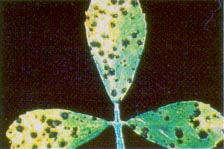
Pseudopeziza medicaginis
Symptoms
- slightly raised brown to black spots found on upper leaf surface;
- disc shaped spots range from 1-3 mm in size and rarely coalesce;
- rest of leaf remains green; and
- infected leaves will turn yellow and drop.
Conditions Favourable
- favoured by cool to moderate wet conditions;
- overwinters on plant residue;
- spores released when high moisture and moderate temperature (15-24 degrees C); and
- spores spread by wind and germinate when free moisture is present.
Prevention/Control
- use certified seed;
- use disease resistant cultivars;
- crop rotation;
- plant in well-drained soils; and
- spring burning when severe.
Spring Black Stem and Leaf Spot

Phoma medicaginis
Symptoms
- small, dark brown to black dots on leaves, petioles and stems;
- leaf spots enlarge, coalesce forming irregular blotches;
- infected leaves turn yellow, wither and drop;
- black tissue may appear near base of stems;
- crown and root rot may occur; and
- infected seed pods and seed may discolour and shrivel.
Conditions Favourable
- favoured by cool and wet conditions;
- overwinters on dead stems and leaves or in crowns and roots;
- spores released during periods of wet cool weather;
- spores spread by rain splash, wind blown or carried by insects; and
- new shoots exposed through infected residue.
Prevention/Control
- use certified seed;
- use disease resistant cultivars;
- crop rotation; and
- crop rotation; and
- spring burning when severe.
Stemphylium Leaf Spot

S. botryosum
Symptoms
- small, oval, dark brown lesions on stems, leaves, flowers, petioles, pods and seed;
- increase in size with concentric rings bordered by yellow halo;
- affected leaves become yellow and drop prematurely; and
- stem, petiole, and pod lesions are sunken brown or black spots.
Conditions Favourable
- favoured by wet and warm conditions;
- overwinters on dead stems, leaves and on seed;
- spores spread by wind, rain splash; and
- spores germinate when free moisture is present on leaf surface.
Prevention/Control
- use disease resistant cultivars;
- crop rotation; and
- spring burning when severe.
Yellow Leaf Blotch
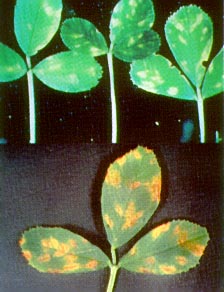
Leptotrochila medicaginis
Symptoms
- most prevalent in late spring and early summer;
- elongated lesions found on upper surface of leaf;
- yellowish-orange blotches parallel to leaf vein;
- sometimes several on a single leaf; and
- under moist conditions, blotches turn from light brown to dark brown to black.
Conditions Favourable
- favoured by cool to moderate wet conditions;
- spores spread by rain splash or wind; and
- overwinters on plant debris.
Prevention/Control
- use disease resistant cultivars;
- use certified seed;
- plant in well drained soils; and
- crop rotation.
Rust

Uromyces striatus
Symptoms
- small, reddish brown, circular pustules on leaves and petioles;
- later elongate pustules develop on stems;
- spores can easily rub off; and
- affected leaves shrivel and drop.
Conditions Favourable
- overwinters in the south and is spread by wind;
- most prevalent in southwest Manitoba; and
- occasionally occurs elsewhere on prairies.
Prevention/Control
- use disease resistant cultivars; and
- weed control practices for alternate hosts cypress spurge and leafy spurge.
Downy Mildew
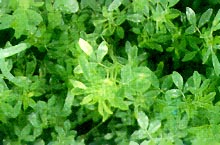
Peronospora trifoliorum
Symptoms
- light green leaves especially at apex of stem;
- greyish-white mycelium on surface of leaves;
- in severe infestations, stems are smaller and leaves become twisted and rolled; and
- disease can cause severe damage to young plants.
Conditions Favourable
- favoured by wet conditions;
- disease infects alfalfa in spring when temperature is low and moisture is high; and
- fungus survivies in shoots over summer and spreads in the fall.
Prevention/Control
- use disease resistant cultivars
Botrytis Blossom Blight
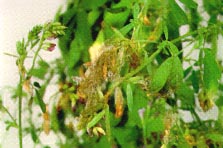
Botrytis cinerea
Symptoms
- abscised flowers clump around the stem;
- occurs first in the lowest blossoms;
- blossoms hang in matted clumps covered by fluffy grey growth, release clouds of spores; and
- shedding of infected flowers can occur.
Conditions Favourable
- occurs with prolonged cool, wet cinditions;
- more severe in dense plant canopy, low spots and sheltered areas with reduced air movement;
- occurs during the flowering stage when conditions are favourable; and
- dry and hot weather will decrease the development of the disease
Prevention/Control
- crop rotation avoiding other host crops such as pea, bean, lentil, and chickpea. Rotate with cereal crops; and
- fungicide application at the proper timing.
Sclerotinia Blossom Stem Blight
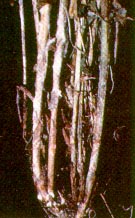
Sclerotinia sclerotiorum
Symptoms
- abscised flowers clump around the stem;
- blossoms hang in matted clumps covered by white growth that eventually develops into hard black sclerotia; and
- shedding of infected flowers can occur.
Conditions Favourable
- more severe in dense plant canopy, low spots and sheltered areas with reduced air movement;
- occurs during the flowering stage when conditions are favourable; and
- dry and hot weather will decrease the development of the disease.
Prevention/Control
- crop rotation avoiding other host crops such as canola and broad leaved crops;
- plant in well drained soils; and
- fungicide application at the proper timing.
Crown and Root Rot Complex
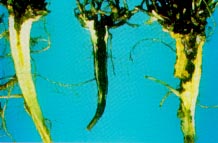
Fusarium spp., Rhizoctonia solani, Phoma spp.
Symptoms
- soil borne fungi;
- yellow, wilted and dead shoots in thinned stand;
- central core of root shows dark reddish-brown discolouration and rot;
- as disease progresses, plants become stunted and eventually wilt and die; and
- causes thinning of stand.
Conditions Favourable
- spores may survive in the soil for years; and
- stress factors including insects, leaf diseases, low fertility and favourable environmental conditions to disease development.
Prevention/Control
- use adapted cultivars;
- plant on well drained soils; and
- maintain soil fertility levels, especially potassium.
Verticillium Wilt
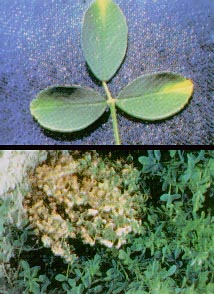
Verticillium albo-atrum
Symptoms
- usually only one or a few stems are affected at first;
- V-shaped yellowing, discolours leaflet tips;
- later spreading to the entire leaf;
- stems remain green and erect as leaves yellow;
- as the disease progresses, stems begin to yellow and become stunted; and
- xylem tissue of the stems may show a light orange discoloration above the crown.
Conditions Favourable
- favoured by cool, wet conditions;
- spread by air borne spres by seed, harvest equipment, manure or infected plant parts;
- diseased plants may be ramdomly scattered throughout the field;
- fungus does not usually survive more than 1 year in field debris once taken out of production; and
- disease survives in borad leaved weeds.
Prevention/Control
- use certified seed;
- used disease resistant cultivars;
- crop rotation;
- weed control to reduce broad leaved weeds;
- where the disease is present, cut healthy stnads first; and
- apply a recommended fungicide seed treatment.
Winter Crown Rot
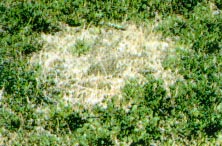
Low-temperature basidio-mycete
Symptoms
- also known as cottony snow mould;
- patches of dead plants that continue to expand in an irregualr pattern from year to year;
- primarily infection show at the apex or base of crown buds or the crown/taproot junction;
- vascular system shows a dark brown discolouration, eventually turning blackish and soft; and
- generally, after the winter melt, infected plants are covered with a cottony white mat of mycelium.
Conditions Favourable
- fungus survives in host residues in the soil; and
- favourable weather conditions for germination: snow cover and subzero temperatures (-10 to -26 degrees C).
Prevention/Control
- winter-hardy cultivars are more resistant; and
- crop rotation.
Bacterial Wilt
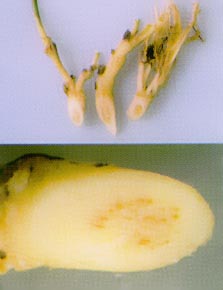
Clavibacter michiganenese subsp. insidiosum
Symptoms
- wilting in early stages of growth;
- as disease progresses, plants turn yellow, dwarfed, leaves may thicken and curl;
- infected plants produce small, bunchy leaves;
- vascular tissue of infected crowns and taproots have a yellow to brown discolouration;
- if disease is severe, the vascular tissue is completely discoloured and rot; and
- infected plants suffer from winter injury and eventually die.
Conditions Favourable
- favoured by wet years;
- infected plants initially wilt during periods of stress;
- infection enters via wounds by insects, nematode feeding, harvest, winter injury or mechanical injury;
- symptoms are slow to develop (visible in the second or third year crop); and
- fungus survives in plant residue, in soil, and seed.
Prevention/Control
- use disease resistant cultivars;
- use certified seed;
- crop rotation;
- plant in well drained soils;
- sanitize harvest equipment to avoid spread; do not harvest when plants are wet; and
- if disease is present, harvest healthy fields first.

